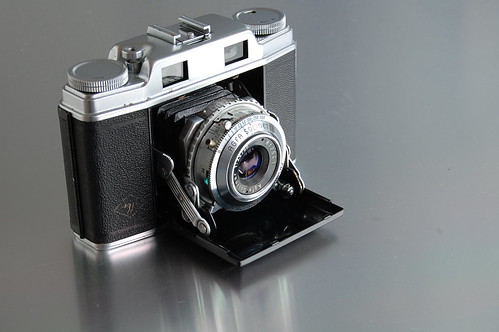Difference between revisions of "Super Solinette"
m (→Notes:: format) |
(Formatting and clarification of some items) |
||
| Line 9: | Line 9: | ||
The '''Super Solinette''' is a folding 35mm camera made by [[Agfa]] in the mid-1950s (1953-58). It is a continuation of the [[Solinette]] line, where "Super" designates a model including a coupled [[rangefinder (device)|rangefinder]]. | The '''Super Solinette''' is a folding 35mm camera made by [[Agfa]] in the mid-1950s (1953-58). It is a continuation of the [[Solinette]] line, where "Super" designates a model including a coupled [[rangefinder (device)|rangefinder]]. | ||
| + | |||
This folding camera is similar in the design to the larger [[Isolette]] [[120 film]] cameras. With a pleasing symmetrical design and circular knobs for film advance and rewind. | This folding camera is similar in the design to the larger [[Isolette]] [[120 film]] cameras. With a pleasing symmetrical design and circular knobs for film advance and rewind. | ||
| − | Super Solinettes came in several combinations of lenses and shutters, | + | |
| − | The diaphragm iris has 10 blades, providing an almost circular shape which | + | Super Solinettes came in several combinations of lenses and shutters, most use the top of the line 50mm/3.5 [[Solinar]] (4 elements in 3 groups) but some are reported to have Apotar lenses. Shutter is either a Synchro-Compur or Synchro-Compur LVS, with Speeds from 1/500-1s and B, self timer and X and M flash sync are found in most cameras. |
| + | |||
| + | The diaphragm iris has 10 blades, providing an almost circular shape which produces very pleasing out of focus area. In early models, the f/stops are stepless, while later models have an EV system shutter in which the speed and f/numbers move together. | ||
| + | |||
Unfolding is performed by pressing a button on the left side, opposed to the top on the [[Solinette]]. Once unfolded, the lens bed is quite rigid, as it is locked in place by 2 struts. The camera can be set on tables or other surfaces for long exposures. | Unfolding is performed by pressing a button on the left side, opposed to the top on the [[Solinette]]. Once unfolded, the lens bed is quite rigid, as it is locked in place by 2 struts. The camera can be set on tables or other surfaces for long exposures. | ||
| + | |||
Like her sister [[Solinette]] the focusing is done by moving the whole front unit; by rotating a serrated dial at the base of the shutter/lens assembly, in the super Solinette, a coupled rangefinder helps with focusing from 1m (3.5ft) to infinity. | Like her sister [[Solinette]] the focusing is done by moving the whole front unit; by rotating a serrated dial at the base of the shutter/lens assembly, in the super Solinette, a coupled rangefinder helps with focusing from 1m (3.5ft) to infinity. | ||
Shutter must be cocked by hand, and a double exposure prevention system allows to make only 1 shot per frame. | Shutter must be cocked by hand, and a double exposure prevention system allows to make only 1 shot per frame. | ||
Revision as of 16:23, 7 March 2022

|
| Agfa Super Solinette image by Raúl Sá Dantas (Image rights) |
The Super Solinette is a folding 35mm camera made by Agfa in the mid-1950s (1953-58). It is a continuation of the Solinette line, where "Super" designates a model including a coupled rangefinder.
This folding camera is similar in the design to the larger Isolette 120 film cameras. With a pleasing symmetrical design and circular knobs for film advance and rewind.
Super Solinettes came in several combinations of lenses and shutters, most use the top of the line 50mm/3.5 Solinar (4 elements in 3 groups) but some are reported to have Apotar lenses. Shutter is either a Synchro-Compur or Synchro-Compur LVS, with Speeds from 1/500-1s and B, self timer and X and M flash sync are found in most cameras.
The diaphragm iris has 10 blades, providing an almost circular shape which produces very pleasing out of focus area. In early models, the f/stops are stepless, while later models have an EV system shutter in which the speed and f/numbers move together.
Unfolding is performed by pressing a button on the left side, opposed to the top on the Solinette. Once unfolded, the lens bed is quite rigid, as it is locked in place by 2 struts. The camera can be set on tables or other surfaces for long exposures.
Like her sister Solinette the focusing is done by moving the whole front unit; by rotating a serrated dial at the base of the shutter/lens assembly, in the super Solinette, a coupled rangefinder helps with focusing from 1m (3.5ft) to infinity. Shutter must be cocked by hand, and a double exposure prevention system allows to make only 1 shot per frame.
The Agfa Super Solinette was also sold in the US as the Ansco Super Regent
Notes:
- Bellows is usually made of leather; pay attention to it as it tears in the corners.
- Also the bellows can get pinched in the edge during folding and can tear at the camera side
- Focusing unit might be stiff, due to the grease in the helicoid hardening (Agfa grease problem).
- It takes patience, solvent and lots q-tips to loosen it.
- Rangefinder adjustment is possible and requires lifting the top cover; which is achieved by loosening both rewind and advance dials.
- The double-shot prevention is very finicky, and has many small parts, don't force it or it can be ruined.